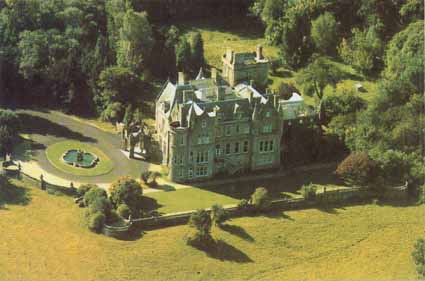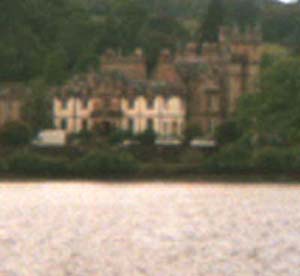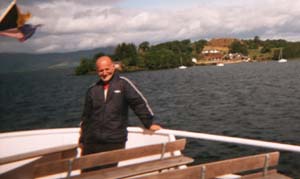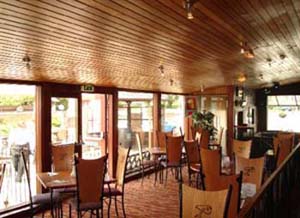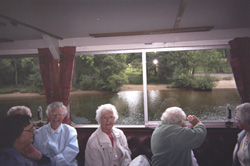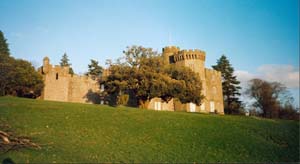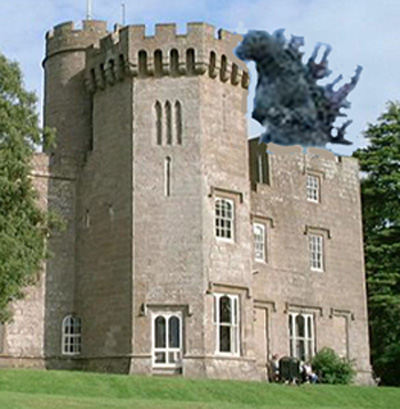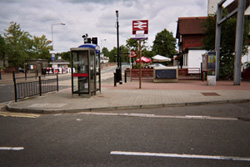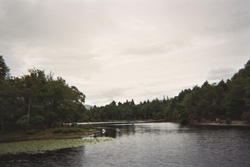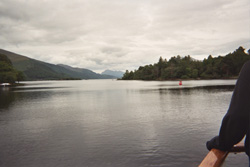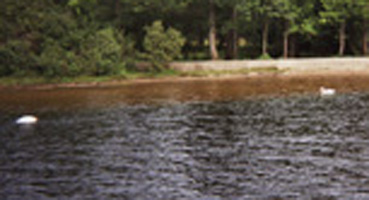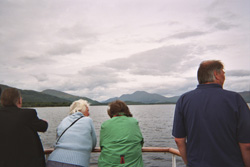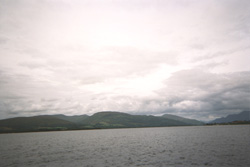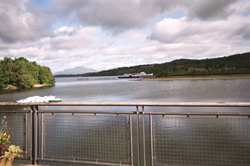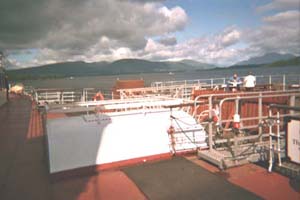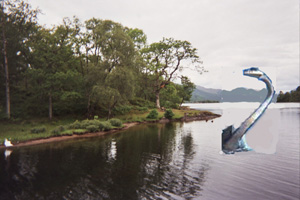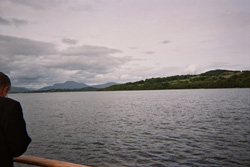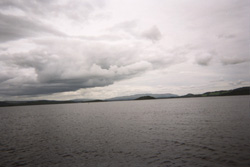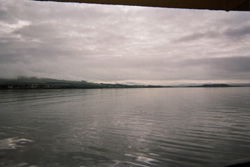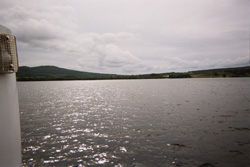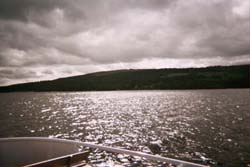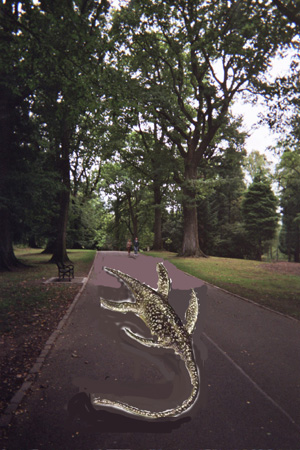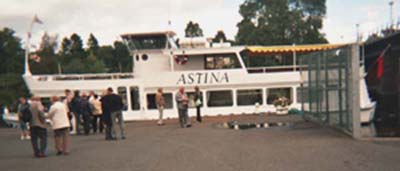Travelogue:Scotland
Balloch and Loch Lomond
August 28-30,2006
The Loch Lomond youth hostel is located at the southwestern shores of the fabled lake. The largest fresh-water body in the British Isles, Loch Lomond has become famous by virtue of a single song that is known the world over:
"You take the high road, and I'll take the low road
And I'll be in Scotland afore ye....."
It is claimed that the grounds of the Loch Lomond Youth Hostel were the site of a hunting lodge of the 14th century king of Scotland, Robert the Bruce. The entrance to this 300 acre demesne is on the highway between the settlements of Alexandria and Helensburgh. The closest town however is a sleepy village called Balloch, less than two miles away. With a 3 block shopping district, plus a shopping mall outside of town ("Shores of Loch Lomond" ) that might have been ordered from a mail-order catalogue, it gives one the impression of existing solely for the accommodation of the tourist population coming in from Glasgow, and from far-flung distant nations attracted by the magic of this one ballad.
I didn't get a chance to visit Alexandria. The friendly staff at the Tourist Information Office in Balloch recommended Helensburgh, a functioning city with all the bustle and diversity implied by this designation.
However the lake's scenic beauty is beyond dispute: for a round-trip busfare of $18 any Glasgow resident can flee the tension and squalor of a large industrial city and soak in the rapturous glory of forests, lakes, mountains, clouds, wildlife, stationary and floating islands, and of course the notorious Loch Lomond monster, Lomonda, whose existence was unknown to me prior to my visit there last month, yet who is well known to the local inhabitants.
At 12:30 PM Monday afternoon, August 28th, a taxi took me from the steps of the Glasgow Youth Hostel at 8 Park Terraxe, to the Buchanan Street Bus Terminal. What I didn't know at the time is that there is a train leaving every half hour for Balloch from the Charing Cross Train Station, which is just down the hill from the Glasgow hostel, a walk of perhaps 4 city blocks. This knowledge would have saved me several hours and about $10.
Entering the bus terminal I went to the ticket counter of Strathclyde Passenger Transport (SPT), stood before a plexiglass shield and attempted to buy a ticket for the bus to Balloch from the young woman sitting behind it. I'd been told at the Glasgow hostel that if one asks the driver this bus will make a stop at the Loch Lomond hostel entrance.
Her lower jaw dropped; she stared at me with dismay. The information they'd given me at the Glasgow Hostel was wrong, she said. The terminal I needed to go to was far over at the other end of Glasgow. She pointed towards a sign identifying the # 20 bus as the one I should board to get there. Fortunately for the success of my journey, the driver of the #20 bus realized that I was being misdirected and sent me back to the ticket counters to speak to a clerk at another booth. This man, a Chinese immigrant, realized at once that I ought to have gone to the ticket counters of Citylink, a different bus company . The booths for Citylink are located less than 6 feet away from those of SPT. I walked over to the line forming in front of them and, in a short time, was sold a ticket to the Loch Lomond hostel for £4.50 without any problems.
I don't normally complain over minor misunderstandings, but this situation impressed me as being exceptional. I approached a driver, who used his cell phone to contact the supervisor of the Buchanan Station. He was there in 10 minutes and I explained the situation to him. He acknowledged the justice of my grievance. The mix-up was understandable,he said: it happens all the time. There is an SPT bus at Buchanan Station which goes to Balloch Central Station without using the highway that passes by the youth hostel. There is another SPT bus, the one that begins its journey at the far-distant terminus, which goes to a stop called Balloch Village which does pass by the hostel. The clerk with whom I had my initial confrontation simply didn't know that a CityLink bus also goes by the youth hostel on its way to Helensburgh! I was happy to learn that I wouldn't be getting her into trouble, though one presumes that she might have had the common sense to realize that I was asking about a stop on the other bus line. Commonsense isn't taught in schools and I'm not sure how one goes about acquiring it.
The supervisor asked me about bus service in the United States. I had the satisfaction of being able to tell him that, at the present time in history, the US may well have the worst public transportation system in the developed world.
The Citylink bus to the Loch Lomond hostel takes about an hour. The bus driver, with refreshing courtesy, let me off with my two pieces of luggage, including the new suitcase whose wheels were about to be tested on the gravel surface of the driveway. Looking across the road I made out the form of the buildings of the deVere Cameron House Hotel and a sign indicating the way to a hotel-restaurant combine called Duck Bay which I would unfortunately be visiting in a few nights. Then I started up the hill.
For about half a mile I climbed a steep driveway bordered by thick evergreen groves . The road branches in a few places until suddenly leveling out onto an open space girded by a stone wall. The space is large enough for cars and motorcycles to park. At its center one finds a pastry-cake extravaganza of Disneyland medievalism christened Archendennan House.
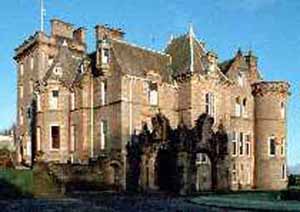
>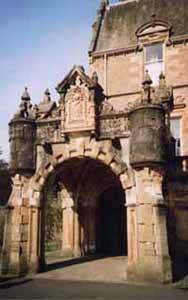
This pseudo-castle was built in the heyday of a craze during the 19th century afflicting notoriously wealthy plutocrats anxious to boast, to a public admiring or otherwise, of their ill-gotten fortunes . George Martin, creator of Archendennan House , had reaped his millions in the Napoleanic era through his management of tobacco plantations in the West Indies, that is to say (given that no free worker would tolerate the conditions on a tobacco plantation) through slave labor.
He reached into his hoards of bullion and bought the hunting lodge of Robert the Bruce. In 1865 he commissioned a well-known architect, John Burnet, to build an exotic monsterpiece worthy of the visionary excesses of Ann Radcliffe , Horace Walpole, Mr. Walter Scott (Americans are not required to acknowledge aristocratic titles), et alia.
From hunting lodge to youth hostel is not an unusual transition: for example, the lavish youth hostel in Los Gatos, California is located in the refurbished hunting lodge of a turn-of-the-century (19th to 20th) millionaire. That the transition should be mediated via a pastry cake monument to kitsch, reminiscent of a movie set for Ivanhoe is assuredly extraordinary, to say the least. The property was sold a few times over the next 80 years until it was finally purchased in 1945 by the Scottish government with a war relief grant bestowed by an association of American trade unions. Once upon a time there were such things.
The back of Loch Lomond Youth Hostel, seen from the lake.
The edifice abounds with arches, architraves, buttresses, coigns, crenellated battlements, epistyles, peristyles, donjons, stained glass and treacherous sweeping staircases. It lacks only a moat. Archendennan House has been used as a youth hostel for quite some time now, over 50 years, and most of its rooms have been retooled for a hostel function, kitchens,dining-rooms, bedrooms, laundry, lounges, and reception areas .
The Ballroom
The most elaborate room in the building, the Ballroom on the second floor, also serves in a more ceremonial capacity, being rented out for wedding receptions. When the Ballroom isn't being rented, it tends to remain empty, although every hosteller is welcome to try to read by its dim lighting or walk around and admire its decor.
"The stag at eve had drunk his fill ... "
Mr. Walter Scott, Lady of the Lake
It may well be the head of the aforesaid stag, stuffed and mounted, that proudly vaunts its antlers on the back wall of the Ballroom at Auchendennan House. Cresting at about 9 feet above ground, it regards hostellers and wedding guests alike with the same disparaging grimace. I looked at it from a chair by an oaken table against the left wall, midway across the room, that is to say about 12 feet away from the reindeer and a much longer distance from the fireplace inset into the far wall to the right. The floor itself, maintained at a high polish, is paved with large wooden tiles, bright ochre in hue, not quite a foot on each side. The patterning is Alhambrian rather than Penrosian, that is to say that it follows a periodic distribution dictated by a few elements of the 17-element wallpaper group that shapes the mosaics of the Alhambra, rather than the irregular, formally undecidable tilings discovered by Roger Penrose.
The dimensions of the Ballroom are about 24 by 36 feet; the central core of the ceiling must be at least 20 feet high! Such a Ballroom must have been the source of Thomas Moore's inspiration when he wrote:
I feel as one who stands within
Some banquet hall deserted
Whose lights are dead, whose garlands fled
And all but I departed!
The illumination for this room, adequate for observing but insufficient for reading, descends from 6 high-hanging chandeliers each holding 5 frosted glass lampshades shaped like inverted bluebells. Directly across from my table, on the opposite wall, stands a grandiose fireplace ( One has seen more grandiose, but it is nonetheless impressive).
The wall surfaces around the room are divided in 3 horizontal sections. From the ground up to about six feet one finds thick wooden panels with intaglio inlays of formal abstract patterns.
The second level rising above this for a distance of about 4 feet is covered with a hand-crafted wallpaper. The embossed gold-leaf images are formed from floral displays of some intricacy. Time has dimmed and blurred the surfaces; from my place of vantage the paper appeared to have the color of a pot of spinach left standing on the stove overnight.
The vault rising above the wallpaper towards the ceiling, painted a combination of whitewash and stucco, is decorated with heraldic emblems and more floral patterns. Logically the ceiling ought to extend horizontally out from its edge; however an additional level has been carved out of the center of the ceiling, rising another 10 feet or so, a kind of window into the cosmos, rimmed by wrought-iron balconies, glass windows and doors, and, against the walls, another range of spinach paper.
Descending back into the Ballroom, the entranceway to this mead-hall is adorned with slender pillars with Corinthian capitals. Above them sits an ogive of stained glass showing more heraldry, surrounded by carved images of winged baby angels. Without a doubt these baby angels ( or putti) had drowned in their baptismal fonts and ascended directly to heaven!
Balloch
Apart from Loch Lomond and the Youth Hostel, there is little to say one way or the other about Balloch. Almost every shop, store or restaurant is closed until 10 AM. There is a restaurant called "Raffles" located in a wing of the Lomond Park Hotel that serves an expensive breakfast from 7 . Corries is a good place for an afternoon coffee break. The library provides Internet access. The Tourist Information Office is staffed by very charming and helpful youngsters. Most necessities can be bought at the "Shores of Loch Lomond Mall" provided one pays for them. It also boasts an I-Max Acquarium, which I didn't visit. I have a natural talent for imagining fish and don't need it:
Hairy Angler
There are numerous little shops for tourists, all of which play the Loch Lomond song from their tape recorders or CD players. The Maid of the Loch is an old-fashioned paddle steamer that has been restored for cruises. Walking into the passenger area one faces a video documentary about the history of the Maid of the Loch. The background music for the video is the Loch Lomond ballad. In the "Shores of Loch Lomond" Mall one frequently hears snatches of the Loch Lomond Ballad. Going into the tourist shop and information center "The Gateway to the Troussachs", one sees the notes and music of the Loch Lomond Ballad painted above the touch screens that provide information about the natural beauties of the region. When I had my ill-fated meal at the Duck Bay Restaurant, the waiter opened the menu to the lyrics of the Loch Lomond Ballad.
The world is sorely in need of a new Loch Lomond Ballad ! I intend to contact the Scottish composer Patrick Doyle to urge him to write another one!
The Loch Lomond Monster
Cruise tours on the body of Loch Lomond are operated by a company located near the Balloch bridge, Sweeney's Cruises (www.sweeney.uk.com ). I took the 1-hour cruise first, on the afternoon of Tuesday, August 29th. When I returned to the Loch Lomond hostel in September I signed for the 2-hour cruise, to confirm impressions I've received which indicate that a plesiosaur, and possibly a whole brood of plesiosaurs, thrive in the depths of this lake.
It was during this second circuit of the lake, which meanders through several islands, both stationary and floating, that I witnessed the surfacing of the Loch Lomond plesiosaur, (vulgarly referred to as a "monster" , but affectionately called "Lomonda" (familiarly "Mandy" ) by Balloch residents.) I was able to take a photograph of Lomonda (reproduced further on in this account.)
It was this tourist from Poland, (on vacation with his wife to visit his son, working as a security guard in Edinburgh) , who drew my attention to a broadening dispersion of the strands of a skein of golden hairs, each about 30 feet long, on the surface of the lake. Such things are treated in Poland as indisputable evidence for the presence of lake-dwelling plesiosaurs, which periodically sheds their manes in this fashion. Living plesiosaurs have been known to the Poles for thousands of years. All Polish plesiosaurs are males. They must therefore brave the perilous voyage across the Baltic and North Seas to Scotland, where all the females are, in order to mate.
I continued to gaze with amazement at these long tangles of gossamer hair, when a clutch of hummingbirds flew in from the north and began darting in among them. The son, whom speaks an acceptable English and translated for his father, explained to me that hummingbirds use plesiosaur body hair in the manufacture of their nests. One can read stories in Chinese chronicles dating back to the Han dynasty, of intrepid cooks making their way to Scotland to trade silk for the choice ingredients of Scottish bird's-nest soup.
At the furthest extent of this short cruise, about 6 miles into the lake, we were startled by a flock of hundreds, perhaps thousands of butterflies coming together over a black swirling vortex of lake water before flying off in every direction. My Polish guides told me that this was an indication that Lomonda has just recently passed by. The butterflies are drawn to her singing, a gentle and monotonous hum.
This observation was later confirmed in a conversation with the waitress at the Raffles restaurant. The character of Raffles, and indeed of the Lomond Park Hotel, can be guessed at from the following images:
>

The waitress told me that during the plesiosaur mating season, from March through June, the inhabitants of Balloch are frequently roused from their beds at around 2 AM by the sound of a low, very loud, strident noise much like a whale's mating song arising from Loch Lomond. The noise goes on for 2 to 4 hours. Indeed this hum reverberates over all of Scotland from the throats of innumerable loch plesiosaurs, all females, the males being situated in Poland, Norway and Iceland, with a few stationed up around the North Pole.
Although the existence of Lomonda and her brood is an open secret in Balloch itself, the information is not divulged to tourists. The town wants to avoid the carnival atmosphere one finds around Loch Ness. Its residents are very protective of their "Mandy" and anxiously shield her from curiosity-seekers and intrusive scientists.
This attitude has been carried to an extreme by Sweeney's Cruises, which actually offers money to those few persons who are lucky enough to witness one of Lomonda's surfacings. Sweeney's uses the data obtained in this way to chart the course of its boats so that they can avoid bumping into the 50-foot long body of the plesiosaur. It is also a form of hush money. The company is afraid that if the news of Lomonda's existence becomes public knowledge, the many senior citizens who travel on these cruises will be scared away.
Further evidence of the existence of Lomonda was supplied by a chance encounter on the grounds near Balloch Castle. This is the major non-acquatic tourist attraction of Balloch. According to a tourist brochure:
"The castle .... built in 1808 .... is a more modern building than the original castle which was destroyed in the mid 1700's (no doubt in the suppression of the Jacobite uprising ) and was the seat of the Earl of Lennox... Balloch Castle is now owned by Glasgow City Council, etc..."
I struck up a conversation with a curious individual, well into his late 70's. He was not exactly thin as a rail might be, yet not that far from skin and bones. The tremor in his hands, which made it difficult for him to control his cane, indicated a long struggle with the bottle. From the baking of his features I inferred some years in the tropics, and the yellowing his skin suggested jaundice. He spoke with a magnificent burr that was sheer music to my ears. He also wore a kilt, something I rarely saw on this visit to Scotland apart from ceremonial occasions.
As he sat on a bench molding pellets of dry bread between his fingers to feed to the birds, he gazed over Loch Lomond with a pair of binoculars. He'd often noted surfacings of Lomonda in this way, so he claimed. As his right eye was made of glass, he peered through the binoculars from his left eye only. The glass eye was cracked. He explained that he was too poor to have a new one made, but that he expected to come into a lot of money once he's published his monograph about Lomonda that he's been working on for the last 15 years.
After I'd won his trust he revealed to me that an entire wing of Balloch Castle, sealed off from the public, is filled from floor to ceiling with plesiosaur droppings. Some of these are fairly recent. One theory is that Lomonda climbs onto the roof of the castle, sits on a chimney and drops her poop into the floor below. Eventually it seeps into the ground or is washed away by the ominpresent rains.
Alleged snapshot of Mandy atop Balloch Castle
He'd worked as a forensic pathologist, and the City Council of Glasgow had given him permission to carry off several wheelbarrows of these turds, dubbed "crotilites" by geologists, back to his lab. In the course of his examination he'd discovered scraps and remains of McDonald's hamburgers, chicken McNuggets and french fries, things that tourists aboard the cruise ships were known to (illegally) drop into the lake.
He relayed the tale of a noted saurologist who'd dived into the loch in search of evidence of past habitation by plesiosaurs, icthyosaurs and pliosaurs, and never been seen again. However the fins, snorkel and pieces from the tanks of atmospheric gases he'd taken down with him were recovered from the room in Balloch Castle that was being used as a latrine by the fastidious Lomonda, an intelligent creature cognizant of the old adage that one doesn't shit in one's own drinking water.
After my conversation with this venerable and sympathetic old codger I began taking notice of the crotilites heaped in mounds along the shores of Loch Lomond and the tributary river Leven. Some of them are in the form of tiny bits of grapeshot, like the ammunition from a beebee rifle. I observed that the needle on my compass went haywire whenever I approached them. From this I concluded that they are highly magnetized and must come from a species of plesiosaur that, probably in embryonic form, had drifted southward on ice islands from the North Pole when a squadron of space ships was sucked into Earth's magnetic field 65 million years ago.
There are other crotilites to be found along the shores of the loch, deposited in the shape of large squares, suggesting that they may have come from the anal orifice of a 30 metre plesiosaur with the taxonomic label of "Pythagosaurus Immensis". According to the latest informed scientific opinion, this creature has been extinct for the last one hundred thousand millennia.
To continue my investigations upon returning to Middletown, Connecticut in mid-September, I had the benefit of some excellent conversations with the eminent dinosaur paleontologist, Jack McIntosh at Wesleyan University. I also discovered that Luis Alvarez, propounder of the Asteroid Hypothesis for the extinction of the dinosaurs, had observed that Loch Lomond contains abnormally high concentrations of iridium. Any significant deposit of this trace metal is evidence for the impact crater of an asteroid. In fact every Scottish loch known to contain a brood of ancient sea reptiles has registered the presence of large amounts of iridium. One is naturally led to the conclusion that these lochs are all impact craters of ancient asteroids that they brought the eggs, sperm and embryos of outer-space saurians along with them.
Further information can be obtained from the organization WHELP : "We Help Endangered Loch Plesiosaurs" at www.whelp.uk.net . WHELP maintains maintain files on hundreds of lochs where one or several monsters are believed to reside.
Pictures from the Loch Lomond Cruises
Balloch train station and telephone booth. To the right, under the bridge lies the tributary river Leven. Across the street Loch Lomond beckons. I have watched this telephone booth being used by a local club of amateur naturalists. They regularly call colleagues at he University of Glasgow to report sightings or new evidence of the presence of Lomonda.
A pass between islands in Loch Lomond archipelago.
Within the passive grey veneer of the lake's surface lies the impassive gray of the sky: grey reflects gray.
There are both fixed and floating islands in the loch. The floating ones come down from the far north and are are permanently cloaked in an aura of fog and mist . There are many legends about the strange creatures that live on them: wallabies, wombats, panthers, ibis and 7-horned goats. There are those who maintain that these creatures were once human beings who were transformed to animal shapes after being lured by nisses who got them drunk with brewed malt whiskey.
Not all the wallabies are mythical. Wallabies were introduced into the loch by Ms. Arran , sister to Mr. Ivor Colquhoun in the 50's. She owned the island outright. Most of the wallabies have migrated to the misty floating islands and there have been no sightings of them in recent years.There is talk of organizing an expedition to the North Pole to observe its population of wallabies.
Converging lines of water, clouds, islands and sky adorn a regal passageway to mighty Ben Lomond. The view is ominous, like the indifference of nature. Vast as the cosmos, the sight of the heavenly vault is lost in the depths of the lake.
Swans by the shores of the loch, near Balloch Castle, visible through the trees to the left. Their size can be deceptive. They are reputed to be able to grab people with their bills and drag them to their deaths in the lake. However, if one knows and shouts their names, they lose all their powers. The swans of Loch Lomond may have been the inspiration for Wagner's "Lohengrin".
Spectators on the viewing deck of the cruise ship Astina. They are looking down into the water,distracted from the sight of Ben Lomond by the disturbance caused by the recent passage of Lomonda.
The parting of the clouds: descending battalions of winged steeds?
Ancient hills rolling under the processionals of massed clouds. The troubled waters partake of their majestic journey. Vastness of time in the compass of an instant.
A view of Loch Lomond from the boardway of the "Shores of Loch Lomond" shopping mall. In the center of the picture is the renovated steamer, "The Maid of the Loch". From this distance it looks like a can of anchovies. Ben Lomond slumbers in the distance.
On board the Maid of the Loch.
There seem to be many elderly people in Scotland, and they appear to be much happier than they are in the United States. I wonder why. Through the windows one sees emerging the first auspicious signs of twilight. Blending of green, brown, white, grey.
This sighting of Lomonda was made on the morning of September 6,2006, at precisely 9:46 and 20 seconds. To the left one sees one of the many floating islands descending into Loch Lomond from the lands of mist and snow.
Lomonda has surfaced for a peek, hunting for wallabies, pygmy bears or chipmunks, her favorite dishes. She is not noted for a fondness for human flesh, but it appears that she finds the residents at the island's nudist colony who covered themselves with body paint irresistible. It is for this reason that body painting has been prohibited in the colony for the past 8 years, during which time there have been no new disappearances of nudists.
She is also looking for a mate. On a bad year there may not be any male plesiosaurs vacationing in Loch Lomond, and she will have to go out to iceland, Norway or Poland to find one.
"Lake waters lapping, with slow sounds by the shore..."
A wraith of adventure glimmers above the silvery lakescape. Elongated rapid ripples "shining like shook foil". The waning brightness of the sky dances syncopation with the dynamic surge of waters.Cloud-nurtured stoic hills.
A troubled lake suddenly darkened by somber clouds and a downpour of rain. What energy in the texture of interlaced buoyancies!: mountains afloat on a layer of molten crust; boats suspended on the lake; clouds uplifted in the sky; the tart atmosphere embracing us.
Ripples, eddies. Jagged fractal edges. Bands of water, sky, cloud, streamlined crests of long lazy waves. Sunlight plays on shining ripples. Thin membranes of color, sparkles of hope amidst gloom; shaking tremors in long flowing lines. The land lies low and sleek, like a hibernating serpent.
Pedestrians on the road leading to Balloch Castle.
